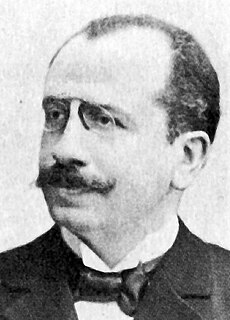
Albert Ballin was a German shipping magnate. He was the general director of the Hamburg-Amerikanische Packetfahrt-Actien-Gesellschaft (HAPAG) or Hamburg-America Line, which for a time was the world's largest shipping company. Being the inventor of the concept of the cruise ship, he is known as the father of modern cruise ship travel.

An ocean liner is a passenger ship primarily used as a form of transportation across seas or oceans. Liners may also carry cargo or mail, and may sometimes be used for other purposes.

Holland America Line is a British/American-owned cruise line, a subsidiary of Carnival Corporation & plc. Originating in the Netherlands, the company moved its headquarters to Seattle, Washington, United States.
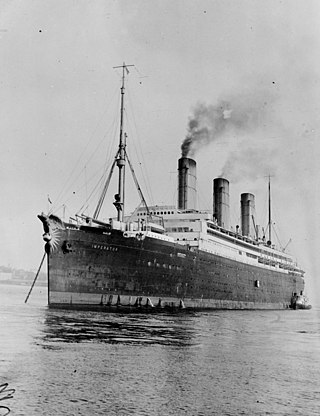
SS Imperator was an ocean liner built for the Hamburg America Line, launched in 1912. Although in German and English all ships are usually referred to as feminine, during his Hamburg American Line career, the ship was referred to as masculine at the special request of Kaiser Wilhelm II. At the time of his completion in June 1913, he was the largest passenger ship in the world by gross tonnage, surpassing Titanic's sister ship, RMS Olympic. Upon launch, he also surpassed the recently-sunk RMS Titanic and the Olympic by 24 ft (7.3 m) in length.

USS Freedom (ID-3024) was a cargo and transport ship in the United States Navy during World War I. Originally SS Wittekind for the North German Lloyd line, the ship also served as USAT Iroquois and USAT Freedom after being seized by the United States in 1917.
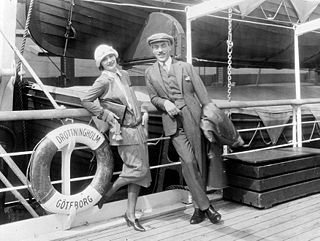
Swedish American Line is a Swedish passenger shipping line. It was founded in December 1914 under the name Rederiaktiebolaget Sverige-Nordamerika, beginning ocean liner service from Gothenburg to New York in 1915. In 1925 the company changed its name to Svenska Amerika Linien / Swedish American Line.

The Scandinavian America Line (Skandinavien-Amerika-Linien) was founded in 1898, when Det Forenede Dampskibs-Selskap (DFDS) took over the steamship company Thingvalla Line. The passenger and freight service between Scandinavia and New York City was operated under the name Scandinavian America Line until 1935.

The Hamburg-Amerikanische Packetfahrt-Actien-Gesellschaft (HAPAG), often referred to as Hamburg America Line, was a transatlantic shipping enterprise established in Hamburg, in 1847. Among those involved in its development were prominent citizens such as Albert Ballin, Adolph Godeffroy, Ferdinand Laeisz, Carl Woermann, August Bolten, and others, and its main financial backers were Berenberg Bank and H. J. Merck & Co. It soon developed into the largest German, and at times the world's largest, shipping company, serving the market created by German immigration to the United States and later immigration from Eastern Europe. On 1 September 1970, after 123 years of independent existence, HAPAG merged with the Bremen-based North German Lloyd to form Hapag-Lloyd AG.
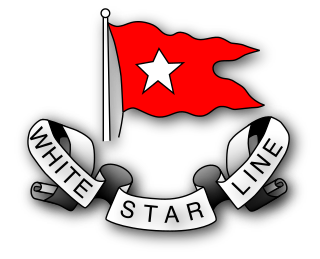
SS Celtic was an ocean liner built for the White Star Line by shipbuilders Harland and Wolff of Belfast.

The SS Cleveland was a steam-powered passenger ship in the early twentieth century. It was operated by the Hamburg America Line and ran between the United States and Germany bringing many immigrants to the Us.

USS Mercury (ID-3012) was a United States Navy transport ship during World War I. She was formerly the Norddeutscher Lloyd liner SS Barbarossa built by Blohm & Voss, Hamburg, Germany, in 1897, and operated by the North German Lloyd Line.

USS America (ID-3006) was a troop transport for the United States Navy during World War I. She was launched in 1905 as SS Amerika by Harland and Wolff in Belfast for the Hamburg America Line of Germany. As a passenger liner, she sailed primarily between Hamburg and New York. On 14 April 1912, Amerika transmitted a wireless message about icebergs near the same area where RMS Titanic struck one and sank less than three hours later. At the outset of World War I, Amerika was docked at Boston; rather than risk seizure by the British Royal Navy, she remained in port for the next three years.

RMS Empress of Scotland was the later name of SS Kaiserin Auguste Victoria, an ocean liner built in 1905–1906 by Vulcan AG shipyard in Stettin for the Hamburg America Line. The ship regularly sailed between Hamburg and New York City until the outbreak of war in Europe in 1914. At the end of hostilities, re-flagged as USS Kaiserin Auguste Victoria, she transported American troops from Europe to the United States. For a brief time Cunard sailed the re-flagged ship between Liverpool and New York.
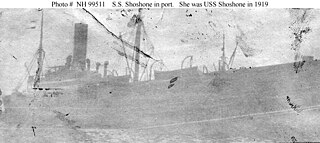
USS Shoshone (ID-1760) was a transport that served in the United States Navy in 1919. Shoshone (ID-1760), the first United States Navy ship of the name, was built in 1911 by Bremer Vulkan at Vegesack, Germany, and operated as a passenger-cargo ship by the Hamburg-America Line as SS Wasgenwald. Wasgenwald was chartered for World War I service by the United States Army on 26 October 1917 from the Custom House, New York, and used as a depot collier with the name SS Shoshone.

USS General W. C. Gorgas (ID-1365) was a United States Navy troop transport in commission in 1919, named for William C. Gorgas. It was a German ship seized by the US Shipping Board after the US entered World War I. Under charter from 1917 from the Panama Railroad Company, it had carried troops and supplies to Europe. After being used as a troop transport to return troops from Europe in 1919, later that year it was converted back to commercial use as a passenger and freight ship operated by the Panama Railroad Company.

Thingvalla line was a shipping company founded by Danish financier, industrialist and philanthropist Carl Frederik Tietgen in 1879 in Copenhagen, Denmark. It maintained a route between Copenhagen and New York City calling at Kristiania and Kristiansand on the way. At its peak, it had ten ships in its fleet. In 1898, the company was bought by DFDS, another Danish shipping company, and the name was changed to Scandinavian America Line.
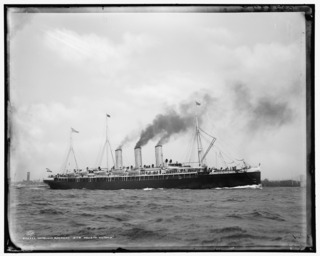
Augusta Victoria, later Auguste Victoria, placed in service in 1889 and named for Empress Augusta Victoria, wife of German Emperor Wilhelm II, was the name ship of the Augusta Victoria series and the first of a new generation of luxury Hamburg America Line ocean liners. She was the first European liner with twin propellers and when first placed in service, the fastest liner in the Atlantic trade. In 1897, the ship was rebuilt and lengthened and in 1904 she was sold to the Imperial Russian Navy, which renamed her Kuban.



















